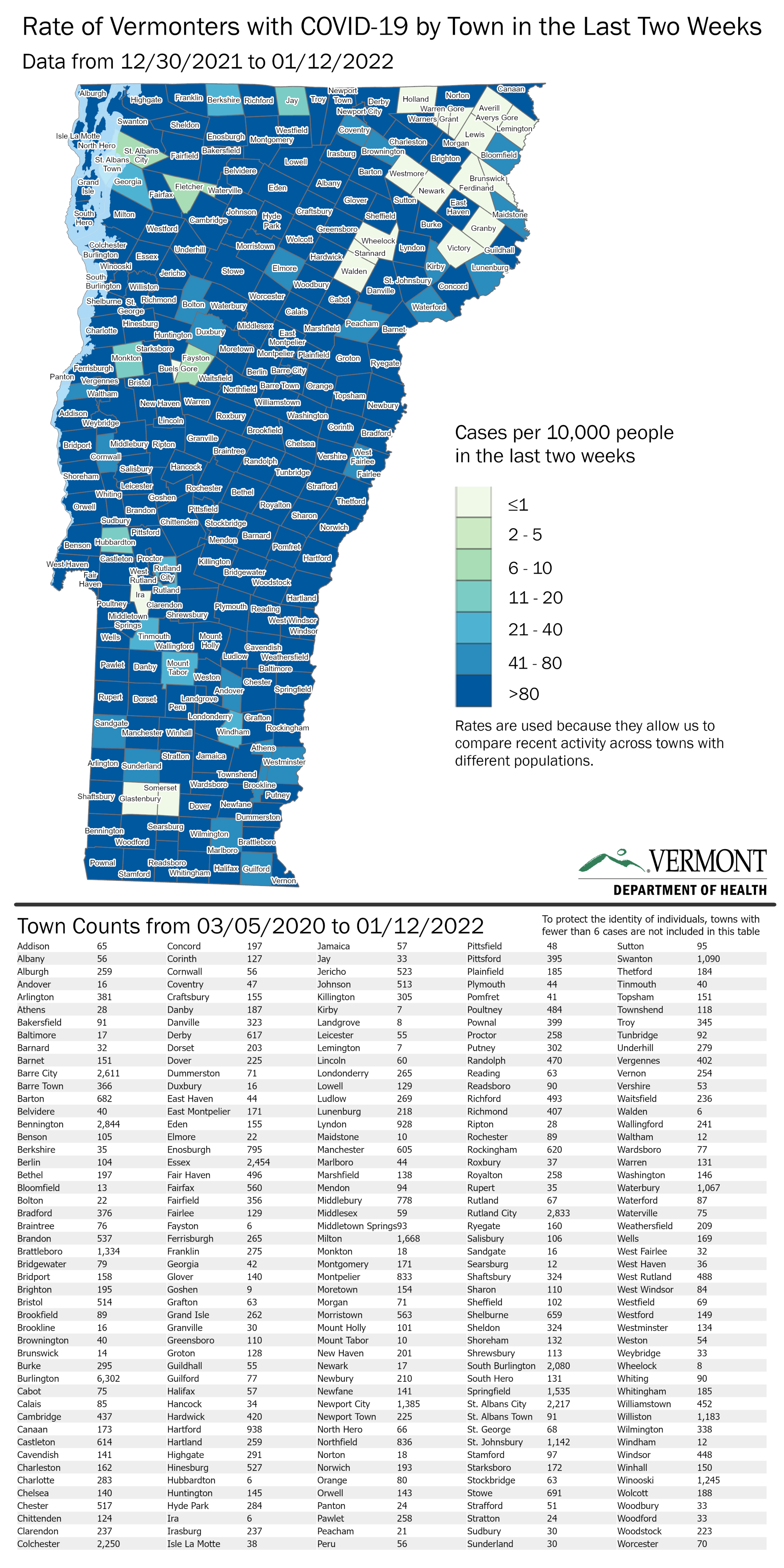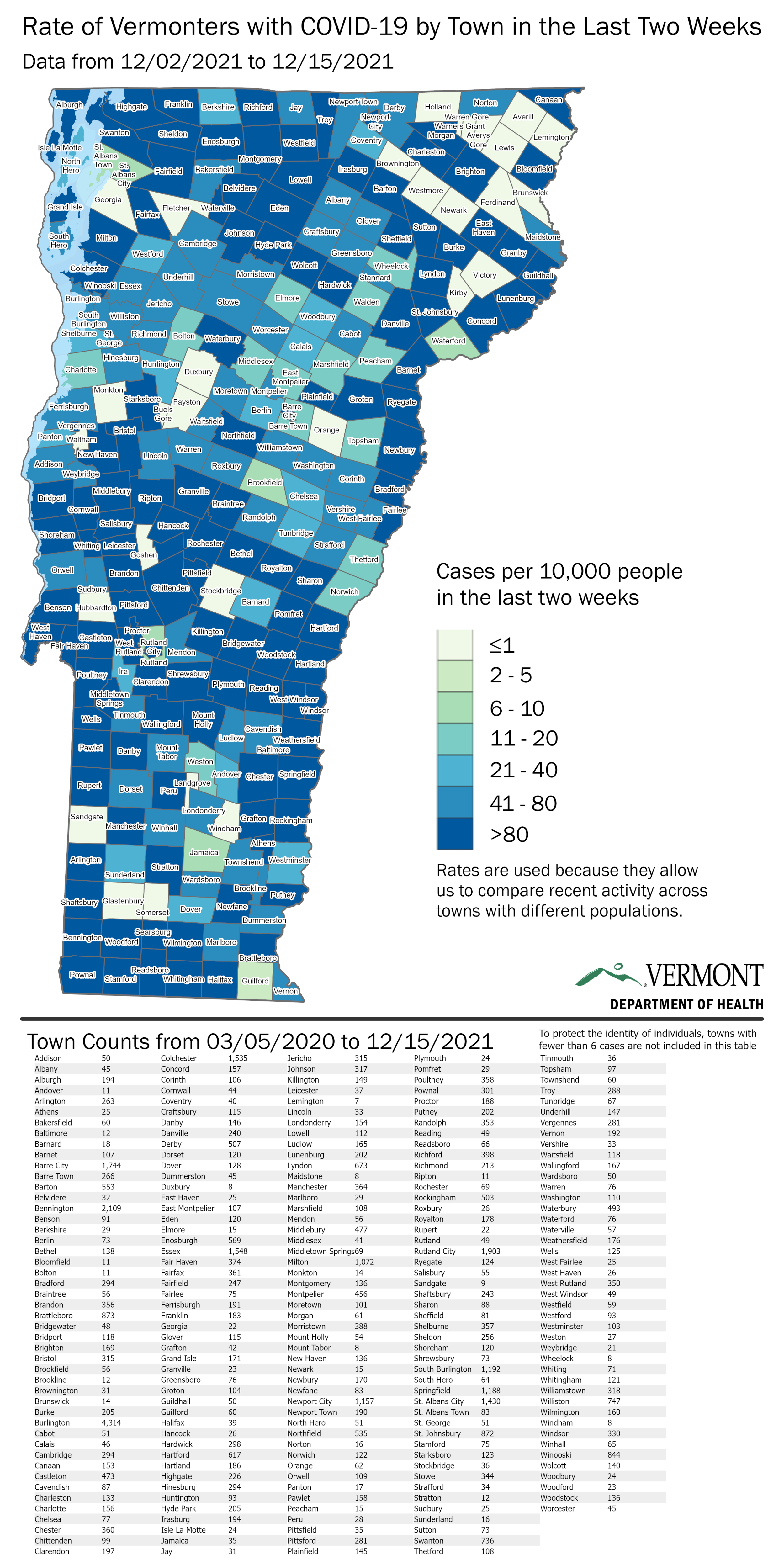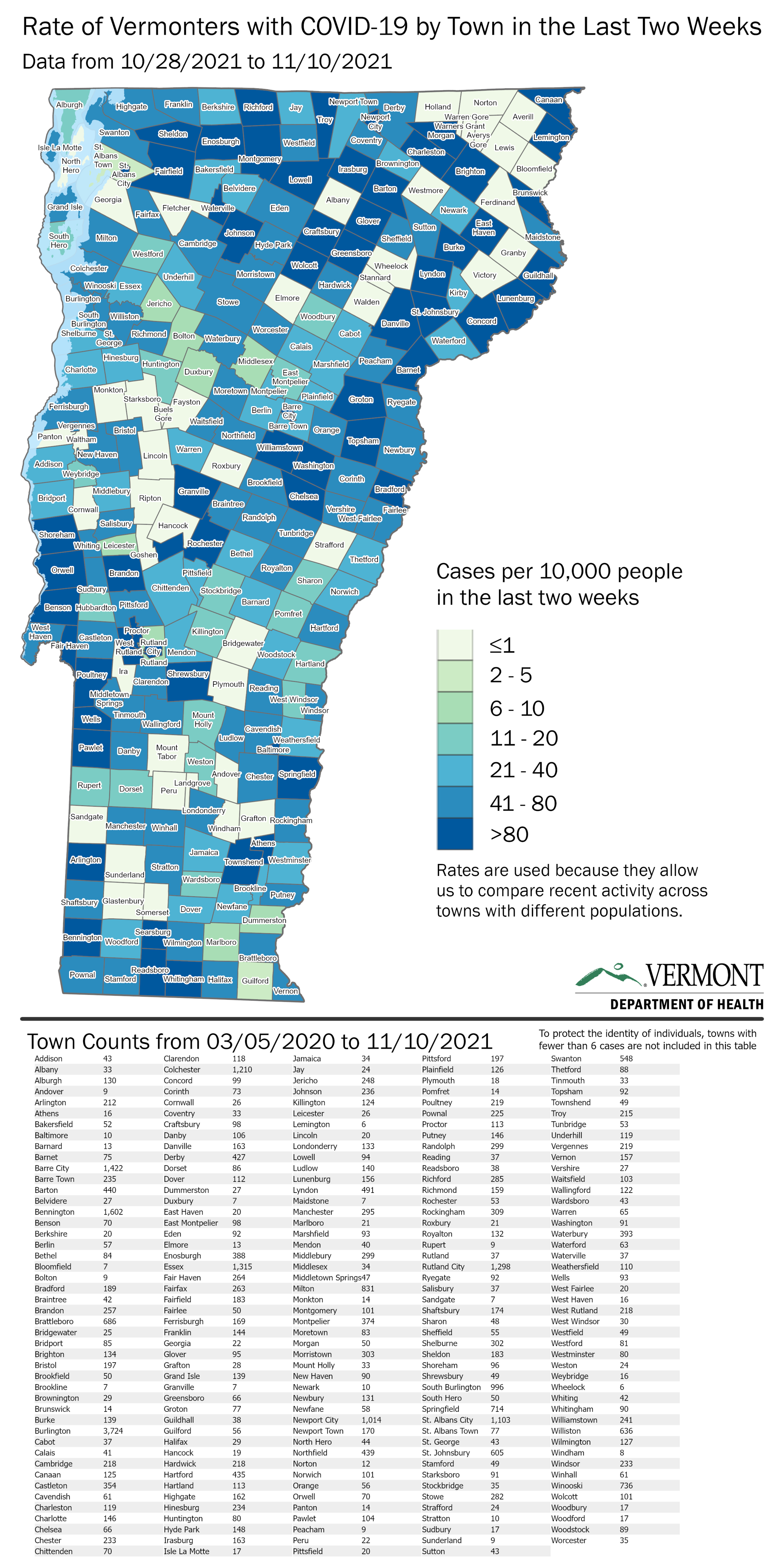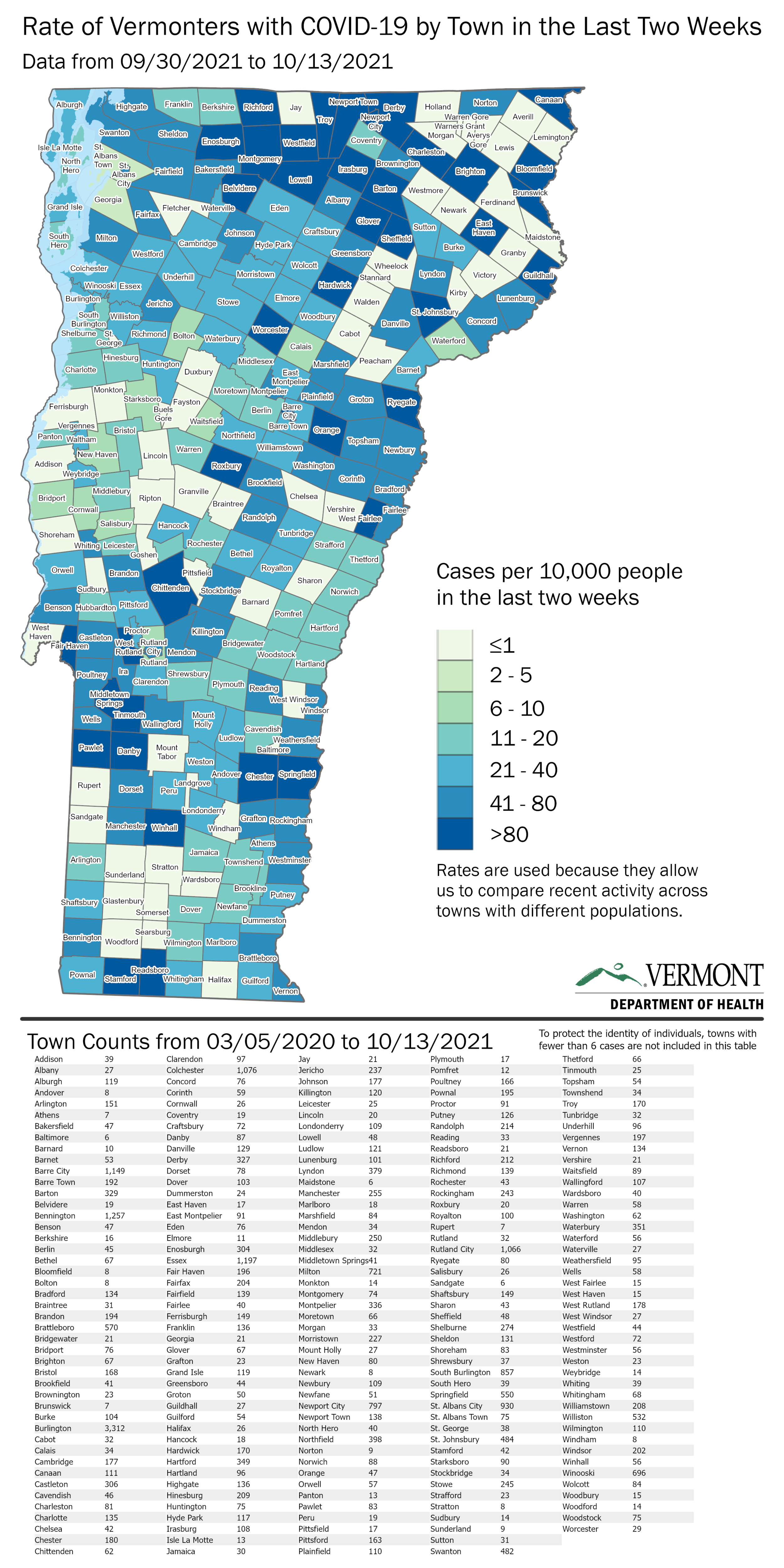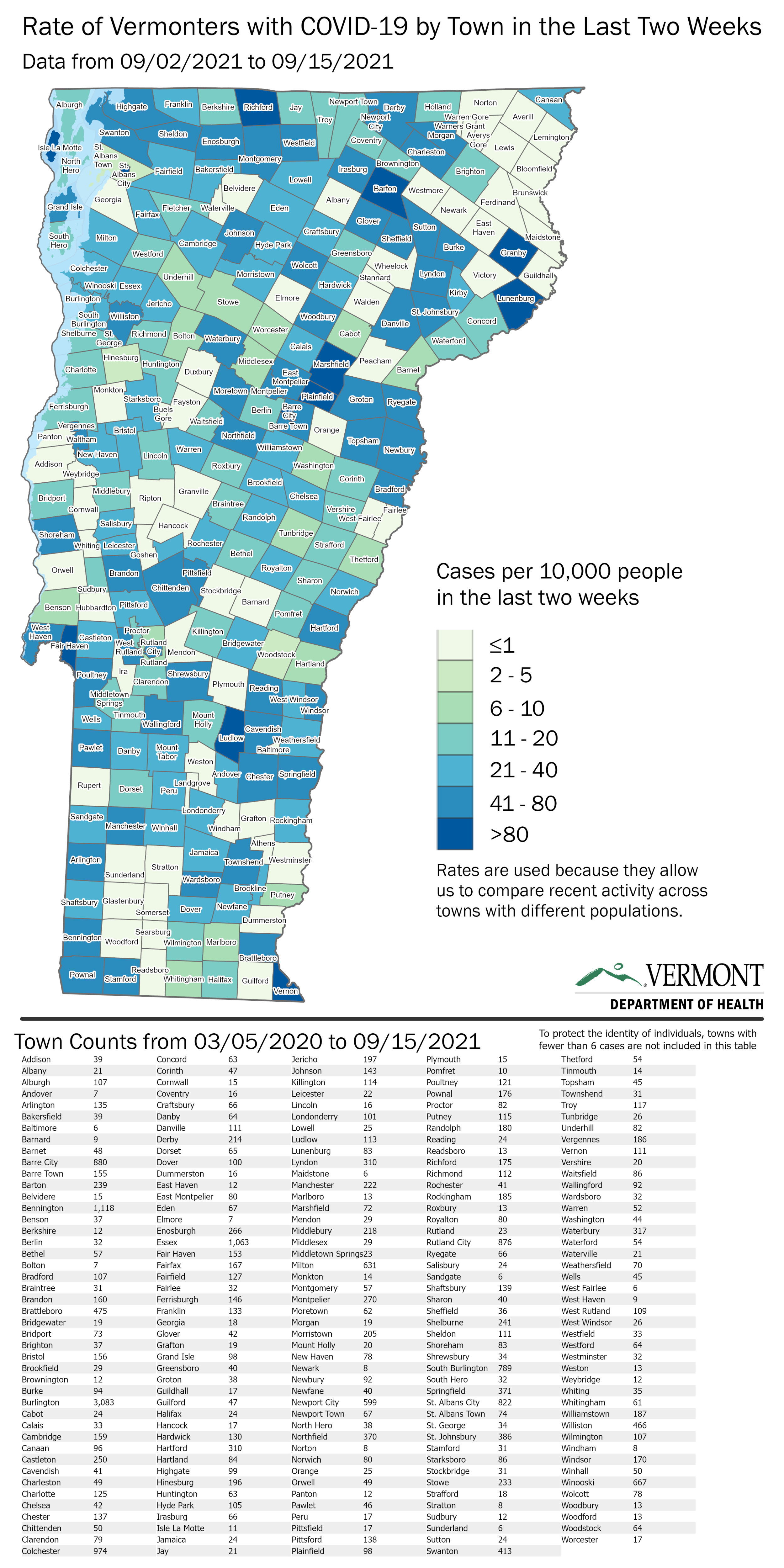COVID-19 spread sets new records everywhere
New school procedures now expected out by Monday
Jan. 15, 2022 | By Lisa Scagliotti Barely into the new year two weeks and the COVID-19 pandemic is setting new records across the nation, in Vermont, and locally in Waterbury and its neighboring communities.
New case counts have reached levels unseen to date in the pandemic that’s nearly two years old. For Waterbury, that meant 286 new cases recorded in the seven days ending Jan. 12, according to the Vermont Department of Health.
In Vermont, new daily case reports have exceeded 2,000 on several occasions in the past week -- 2,295 cases reported for Jan. 13 and a revised total for Jan. 7 came in at 2,983. As of Friday, the seven-day case average for the state is nearly 1,800, according to Health Department data.
Hospitals around the state are straining as the number of COVID-19 patients reached 100 this past week with two dozen in intensive care. And like many businesses and schools, hospitals are scrambling to manage staffing levels as health care workers themselves are out sick or caring for sick family members.
The state’s largest hospital, University of Vermont Medical Center, recently implemented its emergency staffing plan whereby it is shifting staff to meet the most important needs, putting personnel in different departments and possibly leaving other areas temporarily short-handed.
Midweek the hospital reported more than 400 staff were out of work themselves.
Community adjustments
In the Waterbury community, various businesses and organizations are making adjustments in operations to remain open while managing the impacts of the recent virus surge. Here are a few examples from this past week:
The Waterbury Area Senior Center has paused congregate lunchtime meals for two weeks. Seniors may sign up to be added to the Meals on Wheels free delivery list.
The Waterbury Public Library has postponed some of its in-person programming such as preschool storytimes and a live music event. Other presentations will be conducted online via Zoom. Check the library website for the most up-to-date information.
More businesses are asking patrons to wear masks indoors to curb virus spread among customers and staff. In a message on social media this week, Jimmz Pizza in Waterbury Center said: “Jimmz Pizza is asking everyone to wear a mask when inside the building except if seated at one of our few tables. Thanks for understanding. Hopefully Covid numbers will go down soon and we can go back to no masks.”
Others are pausing for temporary closures as exposures and cases affect staff. “We are sorry to inform you that we had Covid exposure,” Blackback Pub owners told patrons on Facebook. “We will be closed until Tuesday, January 18th in order to ensure our employees health and protect our customers. We appreciate your understanding.”
Tests arrive by mail
State-supported PCR testing continues at sites around Vermont including daily testing at the Waterbury Ambulance station located at 1727 Guptil Road in Waterbury Center.
Some changes have also occurred this week at the testing site in Berlin run by Waterbury Ambulance. The site on the Barre-Montpelier Road behind Burger King has moved to appointment-only testing. A second testing location has been opened nearby at the Berlin Mall for individuals to walk in without an appointment. Both sites have daily hours listed on the state testing location website.
While the system has been running relatively smoothly with results available within 24-36 hours, significant delays occurred last week where people waited days for information on their tests. The state system reporting daily cases based on testing paused for several days over last weekend and early in the week as data was sorted and categorized.
Meanwhile, efforts to ramp up home testing are underway. Many retailers are still unable to obtain a steady supply of home test kits. Checks at pharmacies in particular find more “out of stock” messages than tests on shelves.
This week, however, Vermont took part in a pilot program with the federal government where residents were able to order home rapid antigen test kits online. Amazon.com is managing the fulfillment of the orders with deliveries by the U.S. Post Office. Ordering went live on Wednesday with 350,000 kits -- two per household -- snapped up in a short time. Many kits began arriving in mailboxes on Friday.
State officials said another 150,000 kits will be made available for a second round of ordering soon.
That date has not yet been announced. The website for that program is linked on the state Health Department’s COVID-19 testing page.
At this week’s COVID-19 press briefing, state officials were asked about the integrity of the test kits if they are left out in the cold. Temperatures Friday and through this weekend are forecast to be well below freezing and test kit instructions say to store them above freezing. VTDigger reported that experts advise to bring them inside as soon as possible and to use them once they are at room temperature.
State officials urge the public to report the results of their home tests so that cases found through home testing are included in data reporting. A short online form is available for people to do so.
Local numbers
The state Health Department updates COVID-19 case data weekly by town each Friday with new reports current through Wednesdays. Along with the town numbers is a color-coded map showing the two-week rolling case averages. This week’s update covers the period from Dec. 30 to Jan. 12.
The current report shows these new case levels in local communities:
Waterbury at 1,067 for the pandemic. That’s up 286 over the previous week, the highest one-week total to date, more than double the previous one-week high of 130 cases reported on Dec. 29 (that jumped from 41 cases reported Dec. 22)
Stowe’s report this week was a record 142 new cases for a pandemic total of 691.
In the communities of the Harwood Unified Union School District, 378 new cases were reported. Waterbury had the most by far. The next highest weekly totals were 53 cases reported for Waitsfield and 21 in Warren.
In Central Vermont, new record high case counts were reported in numerous communities. Barre City this week had 434 cases reported for a pandemic total of 2,611; Barre Town added 52 for a total of 366; Montpelier saw 174 new cases for a total of 833.
Schools look to chart new path given Omicron
This week was the second week schools were in session after the holiday break. The first week back saw a surge in cases among students and staff that continues to ripple through families and, in turn, school.
Tuesday’s extremely cold temperatures prompted many schools around Vermont to call their first “snow day” of the winter including the Harwood Unified Union School District. So far, the district has not had a weather-related closure. Tuesday’s forecast and anticipated low staffing led to the call.
In the four days classes were in session, school officials each evening reported new COVID-19 that came up that day. In all, 30 new cases involving staff and students contagious while at school were reported. Each school except for Fayston Elementary School reported cases. Brookside Primary School had the most, 11; Harwood Union MS/HS reported 8; Crossett Brook Middle School had 5. Moretown, Waitsfield and Warren elementary schools each reported 2.
Changes in COVID-19 protocols for schools are coming as the state Agency of Education has revised its guidance for prek-12 schools this week. On Jan. 7, Education Secretary Dan French alerted school officials to anticipated changes in state recommendations for schools including steering away from contact tracing when positive cases are identified. The state is also looking to shift testing away from weekly surveillance tests to instead rely solely on rapid testing.
State guidance this year is on an advisory basis given that there is no state of emergency order in place for the Education Agency to mandate specific steps in schools.
At the HUUSD School Board meeting on Wednesday, Jan. 12, Superintendent Brigid Nease said that administrators overseeing the district’s COVID-19 protocols would review the new state recommendations when they were released and would then update the district’s policies.
She acknowledged that some changes would occur to adjust to the increased volume of cases, student and staff absences, and exposure happening with the current surge. However she said the COVID team was reluctant to abruptly end some practices that have been valuable to date.
Here is a breakdown of several COVID-related topics that Nease addressed:
Surveillance testing: This is the practice of voluntary once-weekly PCR tests for students and staff which school officials say has consistently turned up positive cases where individuals did not have symptoms and did not know they were infected.
Nease said more than 800 staff and students were tested on Monday, Jan. 10. “We wish to continue with surveillance testing and will up until February break and we will revisit it then, if in fact the state will support us by getting us the materials and supplies that we need,” she said.
The state supplies tests and the courier service to handle them. Results from tests done Monday were available by Wednesday morning, Nease noted.
Contact tracing: For months, school staff have been handling contact tracing which involves figuring out which students and staff were in close proximity to someone who tests positive and then notifying them. Given the current Omicron variant of the virus that is highly contagious and spreading quickly, state and local officials agree that these steps will be difficult to continue.
Nease said school leaders are looking to maintain cohort groups in elementary settings, especially at lunchtime when students are unmasked, in order to limit the group size and potential for germs to spread. When there is a positive case in an elementary setting, Nease said, the goal will be to notify the entire class group.
In the middle school and high school settings where students move in and out of multiple classes each day, the process will be different. Nease explained that tech staff are able to track an infected student’s schedule for the day to determine who their contacts were in order to notify them when there is a positive case.
Nease noted that school nurses are seeing many cases spreading within families. For example, of 23 positive cases reported on Monday, 10 were connected to a non-student household member. “We’re finding out almost 50% of positives are related to positives in a household that may not be a student,” she said, adding that new guidance would address this.
Testing: What remains complicated is how schools will manage the supply of rapid tests the state will distribute to be used when cases are identified and students and staff are exposed.
A list of factors come into play including whether individuals are symptomatic, if they are vaccinated, if they have received a booster shot as well as the supply and types of tests on hand to share with families.
Nease said staff are working on the list of steps that will be outlined for specific situations and likely would create a chart to help everyone understand.
The COVID team is also considering new ways to manage test distribution. “We are exploring the capacity to create a drive-by clinic to receive tests,” Nease told the school board on Wednesday.
Masks for all: The school district has KN95 masks for all staff, Nease said, and an order for 10,000 more has been placed. “It’s our intention to make KN95 masks available for all students,” she said.
No remote learning: The state Education Agency remains firm in prioritizing in-person learning and has said it will not count remote learning days towards the mandatory 175 school days required for the year. A waiver process will be used on a case-by-case basis with Education Secretary Dan French deciding exceptions. Nease said the district would take steps to avoid closing schools so as not to have days to make up at the end of the school year.
She said while academics are important, should there not be enough staff to run the usual schedule, students in affected classes would have alternate activities in order to remain in school with the day counting.
New state recommendations were issued on Friday afternoon. Nease said she and other administrators would review that guidance this weekend to then update HUUSD protocols with the goal of having new information out by Monday.

